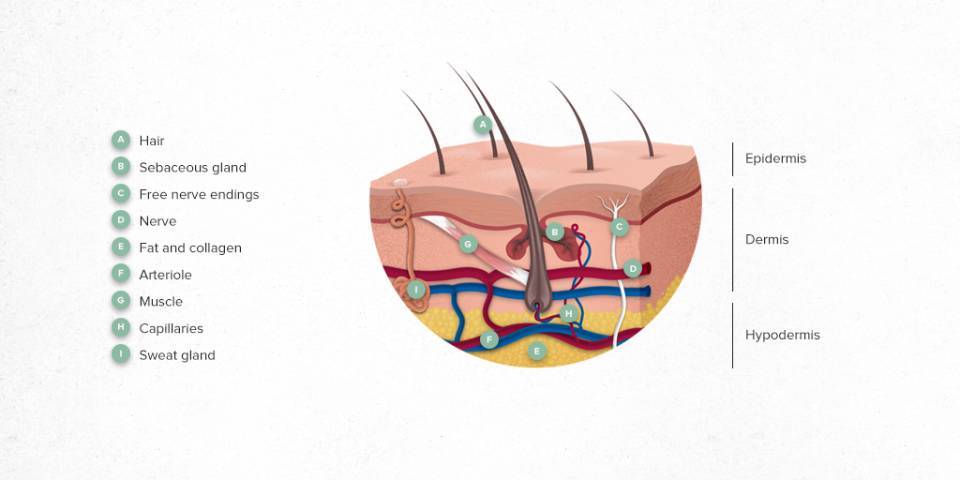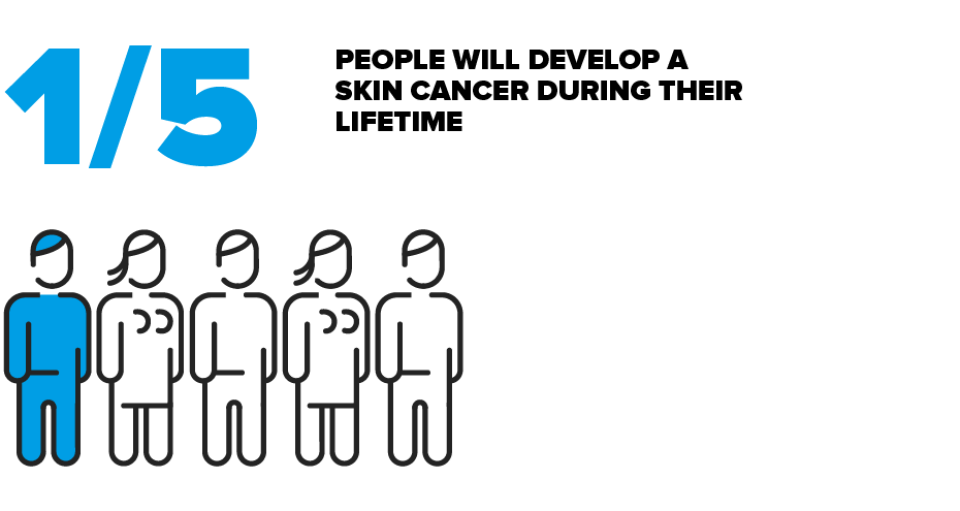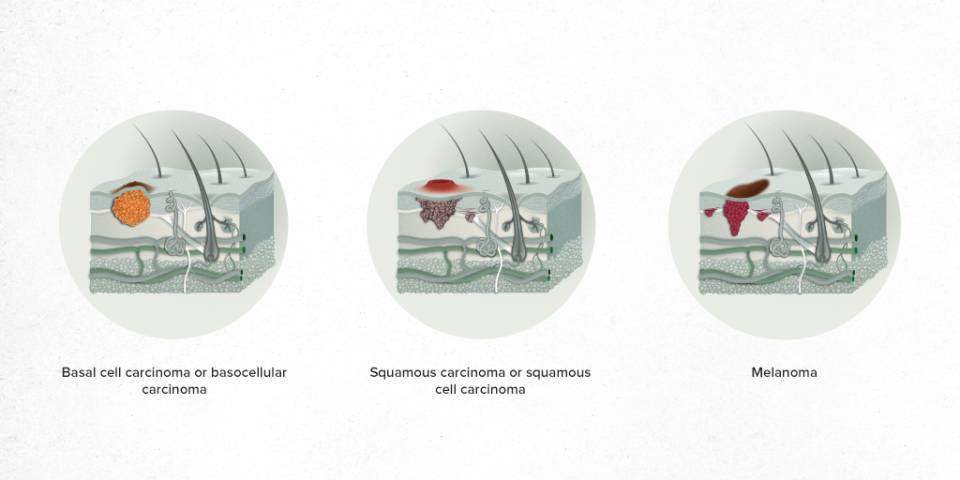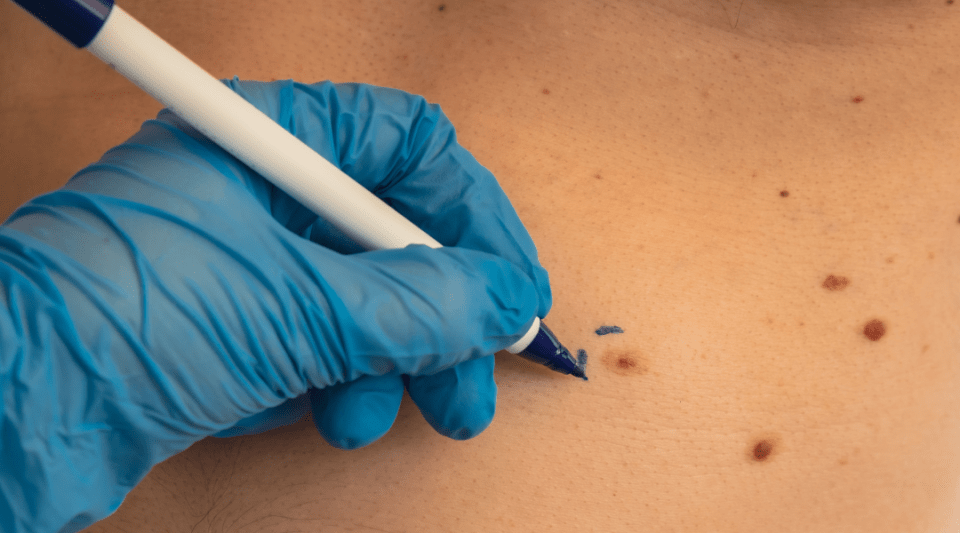17 December 2025
- What is it?
- Risk factors
- Symptoms of Skin Cancer
- Diagnosis
- Treatment
- Disease evolution
- Living with the disease
- Research lines
- FAQ
- Prevention
-
Equipo y estructura
What is Skin Cancer?
Skin cancer is the most common in our population.Fortunately, it has a great advantage over other cancers: its appearance is external and manifests as spots or moles with asymmetrical appearance and size that tends to increase. If detected in its early stages, this cancer has healed, so early detection is critical.
The term cancer encompasses a group of illnesses that are all characterised by abnormal cell growth; cancer cells divide and grow in an uncontrolled manner and in any part of the body. In the case of skin cancer, it applies to a group of different malignant tumours each with a specific diagnosis, treatment and prognosis.
What is skin?
The skin is the body’s largest organ. Its thickness varies between 0.5 mm and 2 cm or more, depending on the area of the body. It is one of the organs affected by external agents, such as the sun, temperature, physical factors and chemical substances, amongst others, and so it acts as a protective barrier. Additionally, the state of our skin warns us about internal illnesses or changes that occur in the skin’s actual cells.
It is a complex living organ with different functions; secretion, absorption, melanin production, temperature regulation, vitamin D activation, storage, detection of various sensations, e.g., pain, pleasure, hot or cold.
We should look after our skin with sunscreen from early childhood, as ultraviolet rays can damage it during any period of the year. You should be aware of avoiding poor eating habits, as well as excessive alcohol consumption, smoking and a lack of rest. These factors play a role in the formation of free radicals, which cause ageing and organ deterioration.
How many people does it affect?
Skin cancer is the most commonly occurring of all cancers in the Spanish population. The annual rate is 300 cases per 100,000 inhabitants. One in five people will develop skin cancer during their lifetime. It is estimated that 50% of people over 65 years will suffer some type of skin cancer and 25% will present two or more malignant skin tumours at some moment in their lives.
Basal cell carcinoma, basalioma, or basocellular carcinoma
This is the most common type of skin cancer. It can be found on any part of the skin exposed to the sun, but it usually occurs on the face. The risk of developing basal cell carcinoma increases for patients who have a family member with skin cancer. And it occurs more frequently in individuals who have a cumulative exposure to ultraviolet light or carcinogenic substances, particularly arsenic.
This type of tumour is more common in women and people over 50 years old. Annually, over 200 new cases of basal cell carcinoma are diagnosed per 100,000 inhabitants.
They tend to grow slowly. They appear as slightly raised, pinkish or pigmented, lesions or nodules which may bleed. This tumour usually has a favourable prognosis when removed at an early stage. It rarely results in metastasis.
Squamous carcinoma or squamous cell carcinoma
This kind of skin cancer is the second most frequent type and develops in patients aged over 50, with light-coloured skin and high cumulative sun exposure. It is most prevalent in patients who have received a transplant and taken a long-term treatment with immunosuppressants.
An average of 38 new cases of squamous cell carcinoma are diagnosed per 100,000 inhabitants per year in Spain. It manifests as a scaly patch of skin that progressively grows into a tumour that may bleed. This tumour usually has a favourable prognosis when removed in an early stage, but in some cases it may metastasise to other organs, especially the lymph nodes.
Melanoma
This is a malignant tumour that originates in the melanocytes of the skin or moles (nevi). Melanoma corresponds to just 4% of all skin cancers but it is responsible for 80% of skin cancer deaths. In Spain, it occurs at a rate of 16–18 cases per 100,000 inhabitants and develops in woman more often than men. While it affects all ages, it is most frequently diagnosed above the age of 55.
Over the last decade there has been an increase in this type of tumour, particularly in people over 60 years old, with a stabilization of cases among younger people, probably due to photoprotection measures. Since the beginning of this century, mortality has been declining, probably associated with early diagnosis and the implementation of new therapies.
Even though exposure to the sun tends to be the main cause of skin cancer, there are areas of the body, such as the sole of the foot, the genitals, the nasal mucosa and around the eyes, which are never exposed to the sun but can still be affected. This means there are also hereditary genetic factors behind some cases of melanoma.
Other skin tumours
There are other, less common, types of skin tumour, such as cutaneous lymphomas, or adnexal or connective tissue tumours. Cutaneous lymphomas initially appear as a red patch that can spread and develop into a tumour. Malignant adnexal tumours have very diverse forms of presentation, as firm, pinkish or pigmented nodules that grow in size and change shape or appearance relatively quickly. In some cases they may produce blood.
Skin Cancer explained in first person
Skin cancer usually has a favourable prognosis with effective and satisfactory treatment.
That they try to put much protection when they go to the beach. That the sun is the one that influences this disease.
Related content
Substantiated information by:


Published: 20 February 2018
Updated: 2 July 2025
Subscribe
Receive the latest updates related to this content.
(*) Mandatory fields
Thank you for subscribing!
If this is the first time you subscribe you will receive a confirmation email, check your inbox






